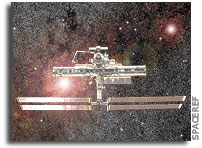NASA Space Station Status Report 6 January 2006

It was back to work this week for the Expedition 12 crew after a long New Year’s weekend that marked the halfway point in their six-month stay aboard the station. Sunday is the crew’s 100th day in space.
Expedition 12 Commander Bill McArthur conducted ham radio contacts with schools during the week, and the crew unloaded cargo from the Progress spacecraft that docked to the Pirs Docking Compartment Dec. 23. The Progress that arrived in September is docked at the aft port of the Zvezda Service Module. The crew uses its oxygen to replenish the station’s atmosphere. The Elektron oxygen generation system will be activated next week after being deliberately shut off in mid-December.
McArthur engaged in computer training for the Foot/Ground Reaction Forces during Space Flight experiment this week. It measures activity and pressure on the legs and feet of crew members while in microgravity. Results will help scientists determine how long-duration missions contribute to bone and muscle loss.
McArthur did a dry run to calibrate the experiment on Wednesday. He also reconfigured power supplies to the station’s computers. On Thursday, he worked with the Binary Colloidal Alloy experiment, which looks at the behavior of fine particles suspended in a liquid in microgravity. Paint, milk and ink are common examples of colloids.
Flight Engineer Valery Tokarev worked much of the week setting up the “Matryoshka” radiation detection experiment. It measures crew radiation level exposure. He set up detectors around the station and spent time with a companion “Phantom” torso experiment, placing about 370 radiation detectors around the horizontally-sliced replica of the upper part of a human body. He mounted the dummy torso in the Pirs for data collection.
Throughout the week, the crew performed additional scientific experiments, installed batteries in the U.S. spacesuits, exercised and performed station maintenance.
For information about crew activities, future launch dates and station sighting opportunities on the Web, visit:
For information about NASA and agency programs on the Web, visit:








